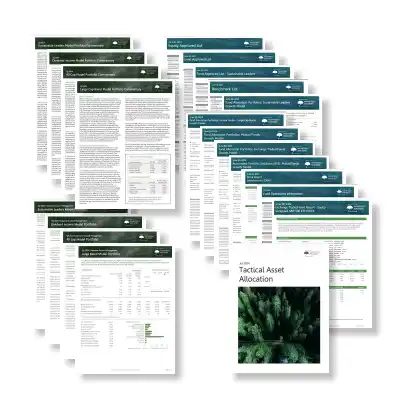Artificial Intelligence’s Monumental Electricity Demand
Published September 2024
– Utilities are preparing for the biggest increase in electricity demand in a generation due to data center proliferation for AI computing.
– Goldman Sachs projects data centers’ power use will more than double by 2030 and account for around 8% of U.S. electricity use.
– Lofty AI ambitions face challenges from electricity bottlenecks in the near-term.
Utilities are preparing for the biggest increase in electricity demand in a generation due to data center proliferation for AI computing and, to a lesser extent, electric vehicle (EV) adoption and increased investment in U.S. manufacturing.
U.S. electricity usage has barely grown over the last two decades as improved electricity efficiencies offset increased demand from population growth. Goldman Sachs equity analysts project that AI’s surging power requirements will lead to U.S. electricity demand growing 2.4% per year through 2030.
Goldman Sachs forecasts data centers’ power use will more than double by 2030, leading to these facilities accounting for around 8% of U.S. electricity, compared to 3% in 2022. The improved outlook for utilities has helped it record the second-best year-to-date return of all the S&P 500 sectors behind only the technology sector.

AI requires a substantial amount of power for training models and responding to user requests. Stanford University estimates that training Open AI’s GPT-3 model required almost 1,300 MWh of electricity.
That amount of electricity is equivalent to the power used by 1,400 U.S. households in a month. Open AI’s ChatGPT service responds to around two million user requests per day, which requires more electricity than 17,000 U.S. households.
In addition to powering AI computations, data centers consume large amounts energy for cooling semiconductors and servers to prevent overheating and malfunction. Cooling is estimated to account for around 30% to 50% of data center energy usage.
Annual Change in U.S. Electricity Demand (Rolling Five-Year Average)
U.S. Data Center Power Demand
(TWh)


The U.S. will need to produce considerably more energy to meet the spiraling electricity demand from technology companies’ frenzied data center buildout.
Renewable energy sources including solar, wind, and batteries will likely play an important role in expanding power generation given the environmental sustainability goals of cloud computing hyperscalers (Amazon, Microsoft, and Google) that provide computing infrastructure to other companies through their massive data center outsourcing services.
However, renewable energy will likely not be sufficient to fully power data centers given issues with solar and wind intermittence, even with supplementary batteries. On demand power sources such as natural gas will be critical because AI semiconductors require constant and reliable energy 24 hours a day.
Brief dips in power can disrupt AI model training. Nuclear energy has also received attention given its constant power supply and zero emissions. Despite nuclear benefits, it might not have a meaningful role in the medium-term because of the longer time and higher cost to build a traditional reactor relative to other energy sources.
The lengthy time and significant cost to increase electricity production and transmission capacity, while also fortifying electrical grid reliability, has become the largest bottleneck for data center construction. These demands might slow the expansion of AI services.
Sam Altman, the CEO of OpenAI, said energy capacity is the “hardest part” of satisfying AI computing demand and might require an energy breakthrough such as nuclear fusion. Data centers’ insatiable energy appetite is already meeting the physical limits of the stodgy energy industry.
According to commercial-real estate firm CBRE Group, constrained power supply is delaying data center construction by two to six years depending on the new equipment needed including transmission lines, transformers, and substations.
A shortage of transformers, complex equipment that regulates electricity voltage, has created a delivery wait time around two years. Meanwhile, setting up transmission lines can take at least a few years given the bureaucratic bottlenecks from getting approval from multiple local and federal government agencies and landowners.
Many utilities are struggling to keep up with the flood of data center connection requests and some are temporarily halting new contracts. For example, Arizona’s largest utility Arizona Public Service has temporarily stopped approving new data center connections while they conduct studies to determine the need for new electrical grid equipment.
“constrained power supply is delaying data center construction by two to six years”
Energy consulting firm Rystad Energy projects the U.S. will need to invest $596 billion in renewable energy projects and spend another $612 billion on electrical grid infrastructure by 2030 to meet growing energy demand.
Utility companies’ investments in the grid are typically passed onto customers through higher electricity rates. Some regulators might be hesitant to approve rate increases given the national average electricity bill already rose 25% from 2018 to 2023 and further increases could face political and customer pushback.
Illinois regulators rejected Exelon’s grid spending plan that included renewable energy projects in December 2023 because the regulators believe Exelon was not doing enough to keep customers’ bills low. Technology companies might be asked to pay their fair share of the cost to provide their data centers with electricity or risk facing longer construction delays.
The challenges of powering the booming data center industry might be a larger hurdle than some investors appreciate and could slow AI’s growth trajectory. Additionally, ambitious renewable energy goals might need to be scaled back in favor of more reliable and abundant fossil fuels such as natural gas.
Technology companies are searching for solutions to the energy challenge including methods to make data centers more energy efficient, investing in nuclear technology companies, and implementing off-grid power sources that connect energy supplies directly to data centers instead of going through the electrical grid.
by Dan Kupiec, CFA, Senior Investment Analyst at MainStreet Advisors
This report was prepared by Mainstreet Investment Advisors, LLC (“Mainstreet”), a federally registered investment adviser under the Investment Advisers Act of 1940. Registration as an investment adviser does not constitute an endorsement of Mainstreet by the SEC nor does it indicate that Mainstreet has attained a particular level of skill or ability. Opinions herein are as of the publication date and are subject to change without notice. This report may include “forward-looking statements” which may or may not be accurate over the long term. Report includes candid statements and observations regarding investment strategies, asset allocation, individual securities, and economic and market conditions.
Statements, opinions or forecasts are not guaranteed. Do not place undue reliance on forward-looking statements. Actual results could differ materially from those described. This material is not intended to be used as a general guide to investing, or as a source of any specific investment recommendations, and makes no implied or express recommendations concerning the manner in which any client’s account should or would be handled, as appropriate investment strategies depend upon the client’s investment objectives. The material has been prepared or is distributed solely for information purposes and is not a solicitation or an offer to buy/sell any security or instrument or to participate in any trading strategy. The value of investments and the income derived from investments can go down as well as up. Future returns are not guaranteed, and a loss of principal may occur.



